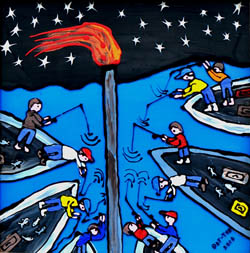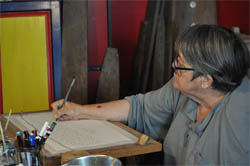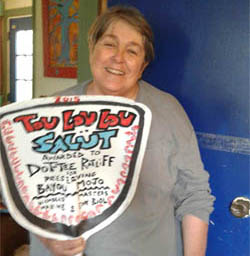Celebrating Heroes of Louisiana's Coastal Communities: The Tou-LouLou Salut
By Gary LaFleur, Jr., Allyse M. Ferrara, Quenton C. Fontenot, Christopher P. Bonvillain, and Delaina Leblanc
The Master of Science degree program in Marine and Environmental Biology was established at Nicholls State University in 2002, under the leadership of Dr. Marilyn Kilgen, Professor Emeritus of Biological Sciences. The program was designed as a 2-3 year program which introduces students to a wide range of environmental issues while supporting them as they embarked on thesis projects involving original research supervised by faculty and published by the university after it passes public and private defense.
Although our department and program might be considered small compared to other universities, we have the advantage of proximity and intimacy with the wetlands that extend from the cypress swamps near Thibodaux, through freshwater marshes, to the saltmarshes of the barrier islands and the Gulf of Mexico. As a strategy to introduce our incoming graduate students to our program we established our annual "Calypseaux Expedition" as an event that melded geography, research, and cultural heritage in an immersive weekend retreat at the coast. As part of these efforts, we began to feel the need to introduce our students to some of the unsung heroes of the coast, who were not included in academic literature or research conferences. These were people whose families had been living on the coast for several generations, leading to the accumulation of traditional ecological knowledge that represented a deep connection to the environment (Bethel et al. 2011). We devised a plan to honor these unsung heroes by presenting them with our "Tou-Lou-Lou Salut," awarded to selected coastal residents that persevered through environmental adversity, and who continue to preserve cultural heritage while being generous to our students in their hospitality and willingness to celebrate the unique culture of the Louisiana Coast. "Tou-lou-lou" is the Cajun word for fiddler crab, and this organism is a perfect example of one of the unsung heroes of coastal ecology, because although they help to cultivate the vast grasslands of the coast by depositing fecal fertilizer and oxygenating the soil with their burrows (Bertness 1985) they easily go un-noticed compared to other more charismatic megafauna such as egrets and alligators. Each year, the award is created as a handmade memento that represents the life's work of the recipient. As a result, there are now markers on exhibit across the coast hanging at marinas and grocery stores indicating that each location is a place that is friendly to graduate students, academics, and cultural explorers.
Thus, over the years we have celebrated the lives of the following coastal heroes:
Theo Chaisson, Isle de Jean Charles
Cecil and Etta Lapeyrouse, Cocodrie
Rickey Verret, Bayou Dularge
Dottie Ratliff, Chauvin
Terry and Sheila Lapeyrouse, Robinson Canal
Sam LeBoeuf, Montegut
Wilton Delaune, Cutoff
Here we present a brief biography of one of our recent award recipients.
Dottie Ratliff, Elementary School Teacher and Folk Art Painter.
Dorothea Theriot Ratliff was born to one of the earliest Euopean families to colonize the wetlands of the Terrebonne Parish coastal wetlands. Her heritage is connected to that of Eloi Theriot, who was one of the founders of the settlement of Theriot along Bayou Dularge. She was born in 1951 and raised in the town of Chauvin along the banks of Bayou Petit Caillou. She was the third oldest child of eight. She shared a bed with her grandmother until she was seven years old, when she was promoted to sharing a bed with her older sister Lee-Lee Theriot Trosclair.

Dottie graduated from Nicholls State University with a degree in Education and began a career as an elementary school teacher, working at several schools along the bayous in the Chauvin area. As a teacher she often used her natural skills as an artist to develop pedagogical tools to use with her young students, designing story books and lessons that she told through drawings. An early example of this was used to teach students about who is responsible for helping to save the marsh, with the answer being "we are." This story book was chosen to be sent to President Bill Clinton in an effort to educate him on coastal land loss.

After retiring from teaching in 2003, Dottie began to paint scenes from her childhood on discarded items, such as old cypress nutria boards, used for stretching and drying out nutria hides. Eventually she transitioned to painting on glass, creating a 3-D effect by painting a background on the far side of the pane, with her story subjects featured in the foreground on the front side of the pane. Her paintings depicted everyday occurrences that have now become rare in modern day coastal cities. For instance, her paintings depict children chasing fiddler crabs, children culling by-catch out of a shrimp net, children running away from the feu-follet, and hiding from the rou-ga-rou. Her paintings also depict occurrences in the lives of her parents and grandparents such as going to work on a crab boat, picking moss, fishing underneath a refinery flare (Fig. 1), or celebrating the annual visit of the broom man. She enhances her paintings with a brief written story on the back of the painting (Fig. 2). By producing her art, Dottie is doing more than making a beautiful piece for hanging. She is documenting stories of life along Bayou Petit Caillou that are quickly being lost as her elders succumb to old-age and her own cohort of playmates move away from the bayou region to higher ground in the big cities of Houma and Thibodaux.

When asked about nostalgia for her childhood, Ratliff stated that she misses the innocence and freedom of the imagination games played by her and her sisters and their neighborhood friends. She remembers making a treasure out of collecting the shed exoskeletons of cicadas in a discarded band-aid box. She would spend afternoons visiting her grandfather's workshop where they would play a windup Victrola while the chickens ran in and out from the yard through the open doors. Her memory of these scenes can still be confirmed and verified by her sister Lee Lee, but each year less and less of her playmates remain to continue the knowledge of their collective reminiscence.
To honor Dottie's work in nurturing the art of children and passing on her traditional ecological knowledge, faculty and students of Nicholls created an award for her by painting a shrimp shovel that had been found washed ashore on Last Island. The surprise award was presented to her by the graduate students during a crab boil celebration for Calypseaux 2015 hosted at Cecil Lapeyrouse Grocery on Bayou Petit Caillou (Fig. 3).
Sources
Bertness MD. 1985. Fiddler Crab Regulation of Spartina alterniflora Production on a New England Salt Marsh. Ecology 66: 1042-1055.
Bethel M, L Brien, E Danielson, S Laska, J Troutman, W Boshart, M Giardino, and M Phillips. 2011. Blending Geospatial Technology and Traditional Ecological Knowledge to Enhance Coastal Restoration Decision-Support Processes in Coastal Louisiana. Journal of Coastal Research 27 (3): 555-571.


